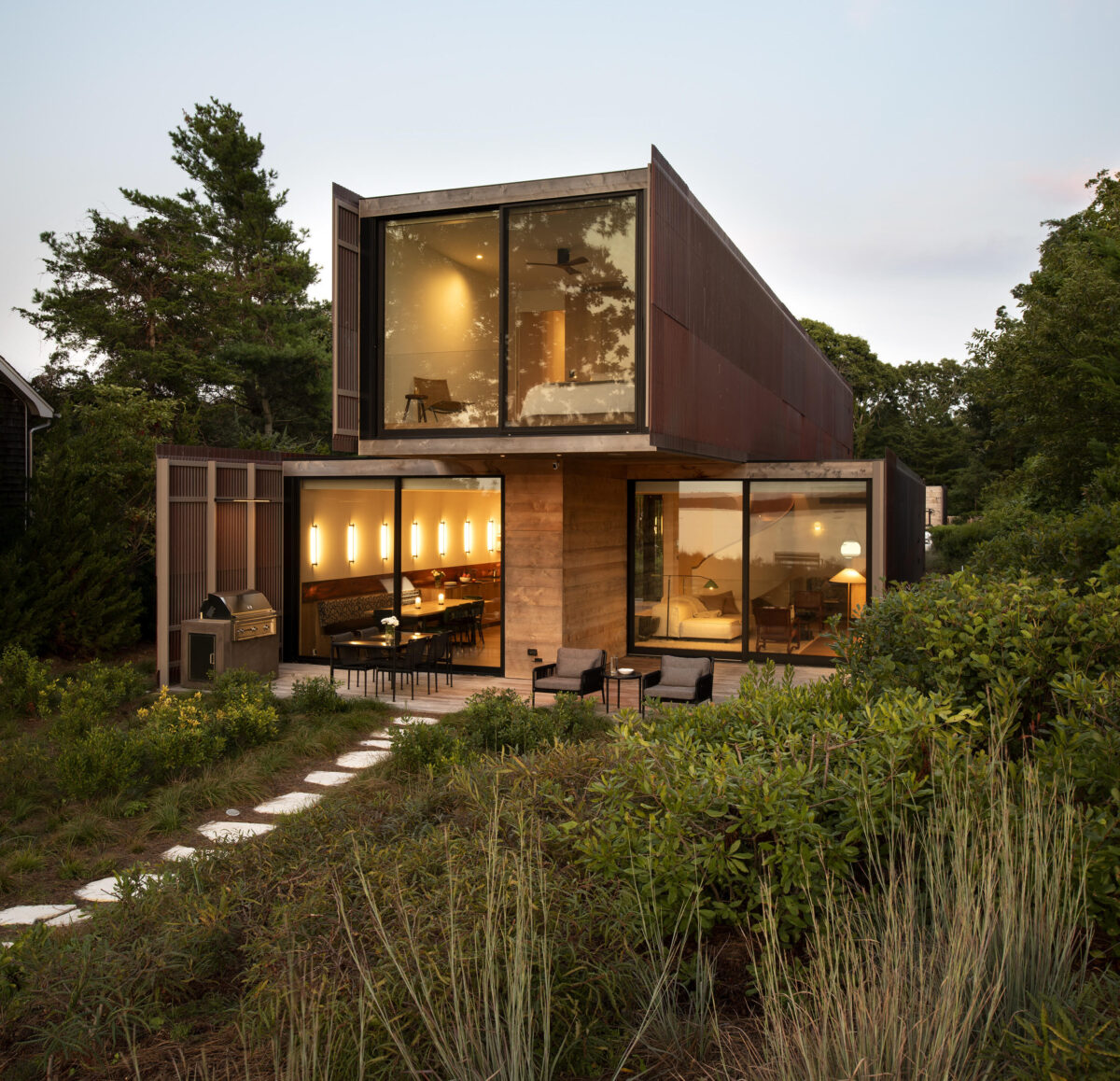
Designing a home on East Hampton’s Three Mile Harbor is a unique challenge for an architect — the land parcels are shaped like needles, maximizing the number of properties that have waterfront. Height restrictions make the already-complicated design even more difficult. But for Paul Masi of architectural group Bates Masi, the challenge was welcome.
“We realized there were some limitations, but that afforded us the ability to take this different condition and shape a very unusual structure,” Masi said. “We’ve never had to work on anything like this before. These challenges, they set up these unique parameters that I think yield interesting solutions.”
The design he came up with stands out from nearby homes. The house slopes upward and gains height toward the water. The structure is sided with telescoping copper pipes, giving both privacy and a standout color.
“We really wanted to find a natural material that would weather over time in a beautiful way,” Masi said.
Three Mile Harbor is known for its intense algae blooms, and some materials can intensify that effect if they leach into the ground. Copper isn’t one of those materials, and over time it will blossom into red and green hues. The choice is practical in more than one way.
The piping is used as a privacy barrier. The neighboring houses are just a few feet away due to the shape of the lots in the neighborhood.
“A solid wall on the sides would be difficult in terms of allowing light to get in. But we also did not want it to feel so enclosed,” Masi said.
The ends of the pipes have also been pressed flat, to resemble oars.
“There’s a lot of references as we developed this with the client to talk about the boating industry … how spaces can serve a dual purpose,” Masi said.
The landscaping is also built around environmental concerns, substituting local foliage for a traditional lawn.
“Lawn is a major contributor to the high nitrogen that would be in Three Mile Harbor,” Masi said.
The client who requested the design, Brad Roaman, has experience in woodworking and gave lots of feedback on the design.
“(Roaman is) not only an avid boater, but he’s also very interested in the craft of construction,” Masi said.
According to Masi, the final design of a house can go through dozens of iterations. Often 15 or more handcrafted models of the design are made throughout the process, showing the elevation of the property, the waterline, and even neighboring structures. Those models make it clear just how unusual the structure is, filling a uniquely shaped lot while still making a one-of-a-kind home.
Roaman is a repeat client for Bates Masi; they built a home about 15 years ago for him. He wanted the home to reflect a maritime theme, and Masi delivered. Space is used economically in the interior, like on a boat.
“We looked at sort of this combination of kitchen and dining together, but even one step further, where sort of the cabinetry for the kitchen is transformed into the dining seating,” Masi said.
The challenging conditions for the property created a good working relationship between Masi and the client, said Masi, a longtime architect on the East End, with an office in East Hampton.
“He was an active part of this process, and a really good partner to work with, because we would have conversations about these ideas, whether it was the siding and how one would fit within another,” Masi said. “And he really appreciated that and would push us, as well as us push him … (it) became a really good relationship in terms of exploring some of these design ideas.”
Roaman says that he enjoyed working with Masi.
“People have to trust their architect and especially when you hire a person like Paul, who’s very creative, and has very interesting ideas … you have to let them run with those ideas,” Roaman said. “At the same time, if I felt very strongly about something or I had input, he was very open to it.”
Bates Masi has a long track record. They’ve been designing and building second homes around the Northeast since the mid-1960s. Bates Masi has been inducted into the Interior Design Hall of Fame and has been featured in The New York Times and Wall Street Journal.
Masi says that his firm is always currently working on projects around the world, including in Hawaii, Texas and Switzerland.
He likes to think that the firm’s clients are largely those who see the unique perspective that Bates Masi brings to its work and resonate with the individual vision brought to each project.
The final product goes through a lot of hands; a land planner, a civil engineer, a contractor to build the property and a landscaper. Not all of those roles are in play at the same time, but by the end of the process they have all taken a turn. Construction was finished on the home in time for Roaman to enjoy last summer there.
Masi is quite pleased with the final result.
“What I’m really proud of in this project is how it’s so site specific and it responds to the marine environment,” Masi said. “I think that this being an unusual challenge, yielded something that was a unique piece of architecture.”
Roaman says that he gets lots of compliments on the home, even from other architects.
“Every time you come home, it makes you smile if you appreciate that type of aesthetic. People are blown away by it when they see it,” he said.